
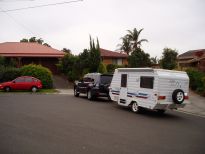 So, then........ Just what is a GOOD TOW VEHICLE for a small caravan? If you only have a small, single-axle, pop-top caravan, say 1000kg -
1200kg, and need a vehicle for other day-to-day usage around town, then the choices
become a bit tricky....... Let's assume the all up weight including your
food and belongings, comes to 1300kg - 1500kg. In our case, a Gazal little Nova, but
it could be any 12'-15' poptop styled caravan. |
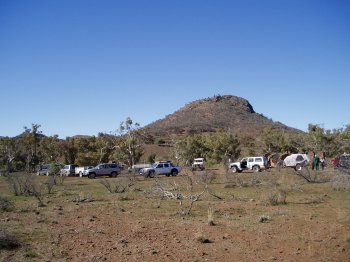 ....... and where might you take it? |
|
here's a few aspects you may have overlooked...... from a 'towing' point of view. |
||
Let's see, you'd probably want: - the comfort of a car or SUV. |
So, the ideal features would have to be: |
|
| So...... Can say, a KIA Sorento EX, Diesel, (5sp Auto) step up
to the task? |
||

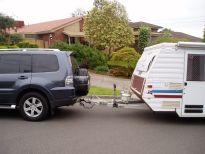 Here are our towing obstacles: a) Angled driveways over culverts......
|
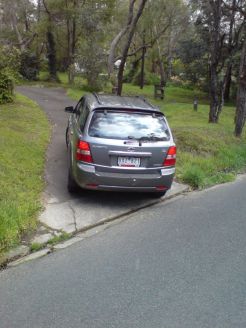 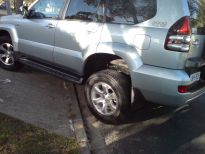 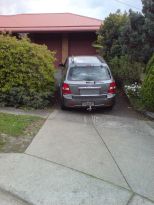 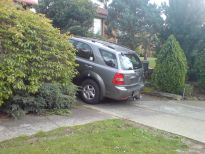
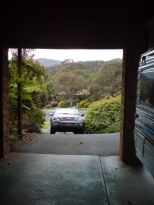 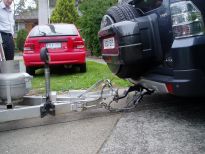
 Looking at the above photos: Check out the towball position, door opening and spare wheel situation in terms of how you connect and lower the drawbar of your caravan to the vehicle. Also, notice what happens when you tow something up a steep hill, if your towbar is positioned too low on the car. |
|
a) Viscous Coupling or transfer case/centre diff? |
Many
SUV's offer "All Wheel Drive" and this is usually front-wheel-drive with
rear-wheel drive assistance when needed. In other words, its a front wheel
drive until you get into trouble. If that's the case, then this is not ideal for
towing. For towing, the weight and traction should be on the rear wheels of the
vehicle, particularly when going up hills. Arguably, AWD, if done correctly
could help with cornering, but not at the expense of front wheel spin, or wear and tear on
couplings/LSD. So, in my opinion, a RWD is best for towing. |
|
| Traction
Control - just what wheels use it? (and realistically, when must you predict the need?) Some vehicles do not immediately make it clear how many wheels, traction control is applied to. And you'd be surprised to discover that some leading brands don't actually provide traction control to al the wheels, in all the modes! ** For caravanners, think about situations where you are in need of traction from the FRONT wheels, if you are driving a 4WD that has 2WD on the rear wheels. ie: slippery manoeuvering where rear wheels are both in trouble. Say, when you are backing a van onto a slippery grass area.. Checkout: Can the vehicle engage an LSD type scenario to the alternative FRONT wheels for a moment? Of course an LSD on both front and back would sort this lot out - but that would be a mongrel to drive around town or on flat surfaces. In serious off roaders, the optional fitting of a DIFF LOCK that locks the FRONT DIFF, seems to be the only way to get serious front wheel traction in addition to rear wheel traction. Such vehicles are best used mainly off road though.
|
Here's a couple
of comments that we've confirmed in discussions with technical representatives, on relying
on electronically controlled BRAKING to facilitate LSD type operations. But
note, they rely on BRAKING the spinning wheel, rather than providing physical TRACTION to
both wheels. - The KIA Sorento has ESP (for oversteer/understeer) and Traction Control for controlling spinning wheels in say, off road situations. But if you select 4WD mode, then the ESP aspect is disabled, BUT traction control remains applied, and to the ALL FOUR wheels. In 2WD mode, if you manually switch OFF ESP, then you also disable traction control, thus leaving no controlling mechanisms to drive both wheels on the back. But in normal operation, in 2WD or 4WD, you have traction control on at least the rear wheels. The good feature of this vehicle, is that you enjoy traction control to the front wheels too, when in 4H or 4L, unlike the bulk of other manufacturers who only brake either of the rear wheels. One subtle difference, is that torque reducton occurs in 2WD, but not so in 4WD, where of course, you do need plenty of torque. So this is very well thought out by Kia. Let's compare it to a similar vehicle: - The Pathfinder ST-L has ABLS to assist with BRAKING spinning wheels when off road, but ABLS only comes into operation if you select 4L. To select 4L you must stop the vehicle and engage neutral before engaging 4H to 4L. This is not a realistic problem if you need to engage say reverse and rely on the front wheels backing up hill in reverse, but if you desire to remain moving forward and discover a need for ABLS operation around a corner, it is not possible (unless you stop and engage 4L). There seems to be a difference between the R50 model prior to 2005 which required a complete stand-still of the vehicle before engaging 4L, and at first reading this requirement was stated to not exist for the more recent R51 models since Dec 2005 - where you could supposedly select 4H to 4L whilst still moving. But the finer print stipulates < 4km/h. That is so slow, you may as well stop, and frankly, that's probably a good idea anyway, to protect the diffs from any sudden grabbing - but why not say so. Also, the question of ABLS availability in other than 4L in recent models, needed lots of clarification. The brochures say it is only 'low range', but technical contacts have said is 4H and 4L. What neither sources show though, is that it is on the rear wheels. So, check if you need to already be in 4L. Interesting, because the o'seas, earlier versions of this model, had ABLS and ABS operatonal in both 4H and 4L, unless you disabled the VDC feature......... so check it out with a test drive and confirm for yourself! Different models offer different features! **Paperwork can be misleading, and at best, be limited in the technical information you need, for making a fair evaluation of facilities.** We're just raising the question here. |
|
| So.... what's available on the market? (October 2007, Melbourne, Australia) Here's what we've test driven - new vehicles AUG-OCT. **legal towing subject to provision of trailer brakes |
NOTE: we've deliberately left out Toyota Landcruiser and Nissan Patrol, on the basis that the caravan being considered is under 1500kg, single axle, and there is no need for really serious off-road 4WD activities. These two fine heavy-duty vehicles are considered overkill for the modest needs under review in this article. They also represent a style of vehicle that we beleive is uneconomical for non-towing day-to-day use around the suburbs. | |
| Pricing and negotiations In the end, you will need to have servicing and you will undoubtedly need to talk about adding things like UHF radios, towing brake controllers, and so forth. In our case we also wanted additional wiring for special accessories. So a good relationship with the dealership you finally do business with, must be a balanced decision based on initial costs, courtesy, service and future costs. So obtain 3 or 4 quotes, meet the service manager and their team - and talk to existing owners of the car you are looking at. Particularly, talk to owners that have used one for say 100,000kms to see how they've gone. |
Here's a list of cost related matters to consider: a) Are you eligible for a fleet, or ABN discount
for purchase? |
|
| Here's some indicative comparisons..... | PROS | CONS |
$65,000 Toyota Prado GX (Diesel) |
Pros: proven, excellent
wheel travel, good gears/diff abilities (4WD-L). Tank: 180L. 410Nm @1600. |
Cons: most expensive, rear door opens outward, has wheel on door, No security blind for rear cargo (not even an option). Length: 4850. Turning: 11.4m. Towing: only 2500kg - small for its size. |
$56,000 Nissan Pathfinder ST-L (Diesel) |
Pros: nice ride
(independent suspension all round), less truck-like, good rear-door setup (rises), ABLS and LSD. 6-sp manual option. 403Nm @2000. 3000kg capacity. |
Cons: also expensive.
Length 4740. Circle: 11.9m. Tank: 80L ABLS does NOT work when in 2WD. ABLS is only applied to REAR wheels. Awaiting confirmation if ABLS works in 4H. R51 models since 2005 require 4H to 4L at under 4km/h - effectively stop to change. |
$55,000 Mitsubishi Pajero GLX 5-door (Diesel) |
Pros:
358Nm @2000 Tank: 88L. Favourably priced against Pathfinder and Prado. |
Cons: rear door opens outward, with wheel on door. Test vehicle went into ECU limp mode, requiring return to dealership to reset. |
$43,000 Kia Sorento EX (Auto) (Diesel) |
Pros: great value for
money, simple 2WD or 4WD hi/lo selection, Small compact size (only 4590L x1884W x
1810H), 392Nm@2000. Security blind (std). tight turning circle: 11m Tow: 2800kg / 280kg ball Ladder frame. TRACTION CONTROL to all 4 wheels. 4H to 4L via switch. Traction control in 4H or 4L leaves full torque if needed. Super low speed (4L) down-hill assist - great! Brilliant lights for night. |
Cons: Tank 80L. Clearance 208mm Servicing outlets in country areas. (yet say, VIC has 45 dealerships versus Nissan who has 46 - so check the locations). Slightly firmer ride, but to be expected for a live rear-axle - worth it for towing ability. |
$44,000 Jeep Cherokee Sport (Diesel) |
Pros: small size, good
price, 400Nm @1800-2400. Towing: 2800kg / 280Kg ball. size: 4496L x 1817H x 1819W angles: 36d(A)/31d(D) Selec-Trac® NV242 full-time 4WD system |
Cons: ride, side opening rear door, spare on door. tank: 76L Uniframe construction. |
$39,000 Hyundai Terracan (Diesel) |
Pros: Tremendous value for money. 345Nm @1750 thru 3000 range. 2500kg towing | Cons: limited color range. Unfortunately, now a discontinued line (only Euro III compliant - not current Euro IV) |
| Landrover
Discovery TDV6 (Diesel) specs |
Cons:
Price viscous coupling, servicing costs and injectors, large size, rear door opening style (sideways) |
|
| Toyota Kluger
(Petrol Only) specs |
Cons: Price, petrol only, AWD | |
| Mitsubishi
Outlander VRX Petrol only specs |
Pros: Compact/comfortable. 6 speed auto or manual | Cons: only 1600kg towing. 276Nm @ 4000. No deisel. |
| Subaru Outback
3.0R (std) (Petrol Only) specs |
Pros: Nice car to travel in - but undersized for towing. Price for non-premium model. | Cons: AWD is FWD. No LSD or Assisted braking. Viscous Coupling. 6cyl is 1800kg capacity. Very expensive for Premium models. No deisel. |
| Nissan X-trail
ST-L (Petrol only) specs |
Pros: Low cost for around town as a non-towing vehicle | Cons:
towing 2000kg. AWD (really FWD), no diesel, |
| Suzuki Grand
Vitara (Petrol only) specs |
Pros: | Cons: (Not for towing) Max towball weight only 85kg |
| Holden Captiva
SX (Diesel) specs |
Cons: FWD bias with itsAWD design. Towing only: 1700kg for diesel. | |
| Ford Territory
TX (AWD) (Petrol Only) specs |
Cons: AWD is FWD. (RWD only
model - n/a) towing: 2300kg / 230kg (comparatively low) |
|
| Subaru Forester
XS Wagon (Petrol Only) specs |
Pros: great light off-roader (but not towing) | Cons: no 6 cyl. no low torque. AWD is FWD. Viscous coupling. |
| ALSO: Not
considered by us (UTE shape not desired - but others may like) Note: In our caravanning travels, Hilux and Navara both feature very highly, but you need to decide if you want a UTE type shape. |
Toyota
Hilux Diesel, Nissan Navara Diesel, Holden Rodeo Mitsubishi Triton, Ford Ranger Diesel, Mazda Bravo |
|
| ALSO: Not
considered, (IN our case, a Wagon shape preferred) |
An honorable mention should be made for the FORD BA Sedan, which is a well known and respected tow vehicle, but the writer's needs are for a 'wagon' shaped vehicle to suit day-to-day business use. | |
| ** availability of demo vehicles with proper 50x50 Hayman Reese type towbar, 7-pin wiring and brake controllers. | ** ABS is looking to use portable brake controllers for aiding in the availability of vehicles for demonstrating towing abilities of more than 750kg capacity. It is rare to find demos with legal 1500kg brake systems fitted | |